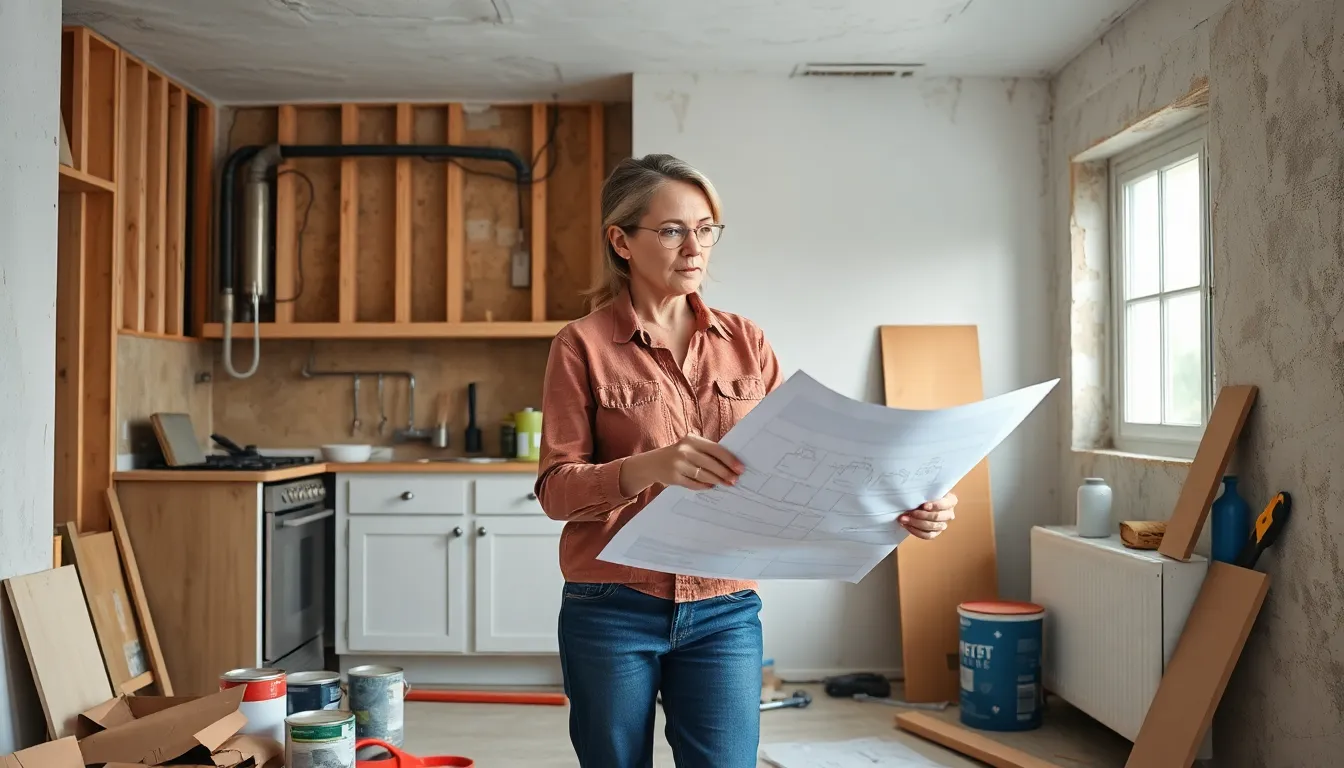Renovating a home can be an exciting journey, but it often comes with its fair share of challenges. From unexpected costs to design dilemmas, homeowners frequently find themselves navigating a maze of obstacles that can turn their dream project into a stressful ordeal. Understanding these common renovation challenges is essential for anyone looking to transform their living space.
Whether it’s dealing with outdated plumbing or managing contractor timelines, each hurdle presents an opportunity for creative problem-solving. By anticipating potential issues, homeowners can approach their renovations with confidence, ensuring a smoother process. In this article, we’ll explore key challenges faced during renovations and provide insights on how to tackle them effectively.
Table of Contents
ToggleUnderstanding Renovation Challenges
Homeowners encounter various challenges during renovations. Recognizing these issues can lead to more effective planning and ultimately, better outcomes.
Common Issues Faced
Homeowners often deal with several common renovation challenges, including:
- Unexpected Costs: Hidden expenses arise from outdated systems or structural issues discovered during renovation.
- Design Dilemmas: Achieving aesthetic and functional goals can create conflicts, such as space utilization versus style preferences.
- Permitting Problems: Delays may occur when obtaining necessary permits, leading to project holdups and increased timelines.
- Scheduling Conflicts: Misalignment between contractor timelines and homeowner availability can disrupt projects.
- Outdated Infrastructure: Renovating spaces with old plumbing or electrical systems requires significant upgrades, complicating timeline and budget.
Budget Constraints
Budget limitations frequently challenge homeowners during renovations. Factors contributing to budget constraints include:
- Scope Creep: Expanding the project’s scope after initial planning can lead to increased expenses and timeline extensions.
- Material Costs: Fluctuations in material prices can strain budgets, requiring adjustments in sourcing or project scope.
- Labor Expenses: Skilled labor costs vary significantly based on local demand, impacting overall renovation expenses.
- Unforeseen Repairs: Discovering issues like water damage or mold can necessitate additional financial outlays not initially included in the budget.
- Financing Options: Limited access to financing options can restrict renovation budgets, forcing homeowners to make tough choices.
Addressing these challenges requires proactive planning and effective communication with contractors to ensure a smoother renovation experience.
Planning and Preparation

Planning and preparation play crucial roles in overcoming renovation challenges. A well-thought-out approach can mitigate risks and enhance efficiency throughout the renovation process.
Importance of a Detailed Plan
A detailed plan outlines specific renovation goals and timelines. Establishing clear objectives helps homeowners stay focused. Creating a comprehensive budget ensures all financial aspects are accounted for, including materials, labor, and contingency funds. Scheduling tasks with contractors minimizes downtime and promotes a smoother workflow. Additionally, determining the required design elements early allows for better alignment between aesthetics and functionality, preventing costly changes later.
Gathering Necessary Permits
Gathering necessary permits is vital for compliance and project success. Local building codes dictate what permits are needed, varying by region and type of renovation. Researching these requirements early prevents delays and fines. Engaging with local authorities ensures adherence to legal standards, improving safety and valuation. Homeowners should allow ample time for permit approvals, as this process can take weeks or longer. Consulting with contractors or renovation specialists can also clarify which permits apply to specific projects.
Structural Challenges
Homeowners often face various structural challenges during renovations, which can complicate the process. These issues frequently stem from outdated infrastructure and compliance with current building codes.
Dealing with Old Infrastructure
Addressing old infrastructure presents significant hurdles in renovation projects. Many properties have outdated electrical, plumbing, or HVAC systems, which can lead to increased costs. Modifying or replacing these systems is crucial for safety and efficiency. Contractors can assess the current state of the infrastructure and recommend necessary updates. Homeowners should expect to invest time and funds in inspections and repairs, particularly in older homes where hidden issues might arise unexpectedly. Planning for potential upgrades can mitigate delays and budget overruns associated with unforeseen repairs.
Addressing Code Compliance
Ensuring code compliance is essential for safe renovations. Building codes vary by location and dictate the standards for electrical, plumbing, and structural work. Homeowners must research the requirements specific to their area. Engaging with local authorities can clarify which permits are necessary for various projects. Having a contractor familiar with compliance can prevent fines and project delays. Homeowners should consider the possibility of needing to modify plans to meet compliance standards, which can add time to the project timeline but ultimately ensures safety and legality in renovations.
Project Management Issues
Managing a renovation project involves several challenges, particularly in the areas of timelines and contractor coordination. Homeowners must navigate these issues effectively to ensure successful completion of their projects.
Timeline Delays
Timeline delays frequently occur in renovation projects, often due to unforeseen circumstances or miscommunication. Weather-related disruptions, delays in material deliveries, and unexpected structural issues can push back project schedules. Property owners must establish realistic timelines that encompass potential setbacks. Implementing buffer periods in the schedule helps account for these unforeseen events. Regular communication with contractors regarding progress can further minimize misunderstandings and keep the project on track.
Coordination Among Contractors
Coordination among contractors is crucial for the seamless execution of renovation tasks. Each contractor—be it the electrician, plumber, or general contractor—plays a vital role in the renovation process. Misalignment in scheduling can lead to downtime and increased costs. Coordinating schedules effectively involves assigning clear roles and setting specific timelines for each contractor’s tasks. Regular meetings between contractors enable collaborative problem-solving and enhance productivity. Homeowners benefit from maintaining open lines of communication with all parties to ensure everyone is aligned with the overall project goals.
Homeowner Involvement
Homeowner involvement plays a crucial role in the success of renovation projects. Effective communication and timely decision-making facilitate smoother processes and help address challenges that arise.
Communication with Contractors
Communication with contractors requires clarity and consistency. Homeowners should establish channels for regular updates and feedback. Weekly meetings can ensure alignment on project progress. During these interactions, homeowners can address concerns, clarify expectations, and modify timelines if necessary. It’s advisable to maintain written records of all communications for reference, which can help prevent misunderstandings. Overall, clear communication fosters a collaborative environment, ensuring that all parties work towards the same renovation goals.
Navigating Decision-Making
Navigating decision-making during renovations involves balancing aesthetics, functionality, and budget constraints. Homeowners should prioritize key decisions early, such as layout and materials, to avoid delays later. Creating a list of must-haves can guide choices and prevent scope creep. Engaging in open discussions with contractors can provide insight into practical implications of design choices. Additionally, utilizing mood boards or samples can help visualize options and aid final selections. By approaching decision-making methodically, homeowners can streamline the renovation process and achieve desired outcomes with fewer obstacles.
Home renovations present a unique set of challenges that can test even the most prepared homeowners. By understanding potential obstacles like unexpected costs and permitting issues, they can navigate the complexities more effectively. A strategic approach that emphasizes planning and communication with contractors can significantly reduce risks.
Staying engaged throughout the project is vital. Regular updates and decision-making can help address issues promptly and keep the renovation on track. With careful preparation and a proactive mindset, homeowners can turn their renovation dreams into reality while minimizing stress and delays. Embracing these strategies sets the stage for a successful transformation of their living space.



